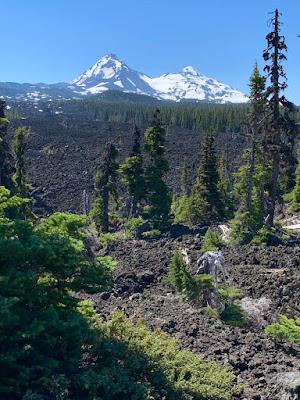
North Sister and Middle Sister as seen from the McKenzie Pass on Oregon Highway 242
My friend Caroline Hatton, a children’s writer and frequent contributor to this blog, took all the photos in this post on June 27, 2022, except for the photo of Scott Lake on July 13, 2022, and the Observatory photo (credit: US Forest Service).
Oregon Highway OR-242, which goes over the McKenzie Pass (at 5,325 feet ~ 1623 m) in the Cascade Range, is closed in winter, as in off-limits, taboo… tantalizing! As I waited for the road to open, month after month, my anticipation of spring snowmelt grew to mountainous proportions.
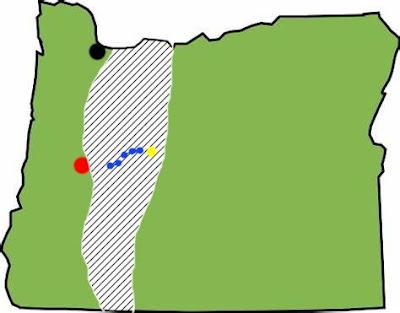
Green: Oregon. Black: Portland; Hatched: Cascades mountains; Red: Eugene;Blue: Oregon Highway 242; Yellow: Sisters.
In 2022 OR-242 opened on June 20. One week later, I got my wish when my husband and I took a day trip to discover the high country from this road. An hour’s drive east from Eugene, we turned onto it.
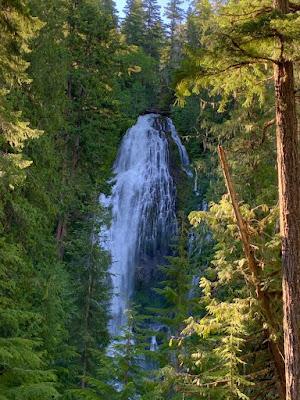
Proxy Falls. Three Sisters Wilderness
Nine miles later, we parked at the Proxy Falls Trailhead. The trail was described online as a 1.3‑mile (~2‑km) loop. After a few steps on it, we passed the boundary sign for the Three Sisters Wilderness.
The trail led through lava rocks and evergreen trees to a viewpoint across a canyon from the waterfall. We didn’t feel like continuing down the next, steep section of trail, so we didn’t get any closer to the water. We were also eager to drive on, to get to the pass in the morning, before the mountain view got hazy under the midday sun.
The highway soon became extremely curvy, turning left and right between tall conifers like in a green canyon, the sunlight angle shifting with every twist, making the forest shimmer. The road climbed switchbacks before straightening some.
We turned left onto Forest Road NF-260 toward Scott Lake, only to face a wall of snow. We were not going to snowshoe or hike with or without crampons, so we gave up on seeing Scott Lake in June and planned to come back at a later date.
Back on the main road, in some stretches the forest thinned and showed scars of past wildfires. When it petered out, most of what we could see was mounds of lava rocks and a dark prominence ahead, Black Crater. Then the Three Sisters rose on the right, honored by their very own Three Sisters Viewpoint. Their glaciers add up to the largest glacial area this far south in the United States.
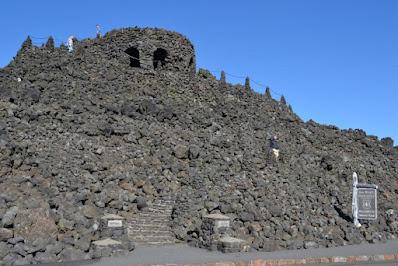
Dee Wright Observatory on Oregon Highway 242. Credit: US Forest Service.
At the highway summit, our car was the third one to park at the Dee Wright Observatory around 10:30 a.m. on a June Monday. The observatory was built of lava blocks, not for astronomers to look at stars, but for travelers to look at volcanoes along the Cascade Range.
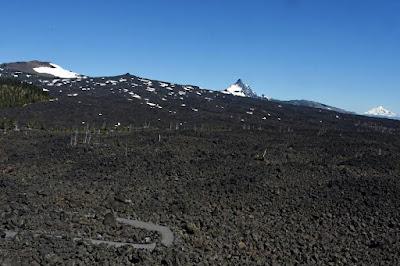
From left to right: Belknap Crater with snow patch, Little Belknap Crater, rocky Mount Washington, snowy Mount Jefferson, and a paved segment of the Pacific Crest Trail, as seen from the Dee Wright Observatory.
We climbed the well-built rock steps to the roof terrace. There, a bronze plaque identified the volcanic peaks in the 360-degree view across 65 square miles (~105 square kilometers) of dark lava rocks—as far as we could see. We spotted Belknap Crater, Little Belknap Crater, Mount Washington, Mount Jefferson (the second highest peak in Oregon at 10,502 feet ~3201 m), and the tiny, pale point of Mount Hood (the highest peak in Oregon at 11,249 feet ~ 3428 m) nearly 80 miles north, so tiny and pale that I cropped it out of the above photo. One level down, inside the round tower, narrow openings through the thick walls aimed straight at the same peaks, named on a plaque below each opening.
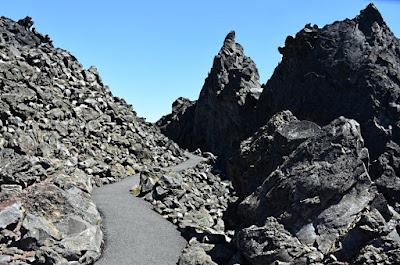
Lava River Trail
Next, we walked on the paved “Lava River Trail” and read its info boards. The Lava River flowed over 2,000 years ago, during a relatively recent volcanic event for North America.
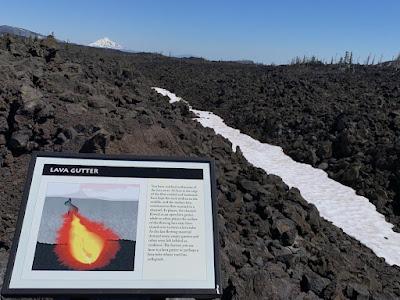
Lava gutter filled with snow. Mount Jefferson on the horizon
Hot molten lava in the middle of the lava river flowed through cooling, harder lava on the edges, then drained away. This left a channel or “lava gutter,” highlighted (but hidden) by snow in the above photo. Snow also filled “cooling cracks,” formed when lava cooled and contracted.
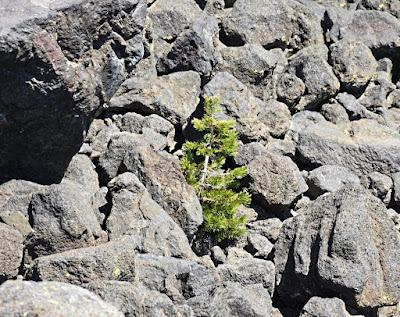
Dwarf, stunted tree (~ 1 ft ~ 30 cm tall) maybe decades old .
Only a handful of tree species can grow in this harsh environment. But their stunted growth may produce only dwarfs, even after many decades.
It was too hot for me to spend more than 15 minutes in full sun, so we walked out and back on only a portion of the half-mile trail. Across the road was the McKenzie Pass sign and beyond it, glaciers on volcano flanks (top photo), a land of fire and ice only two hours from home.
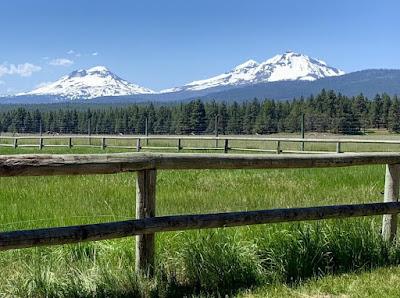
The Three Sisters snowcaps as seen from the town of Sisters.
After driving the winding road down from the pass, through more burnt tree skeletons, then straight across a flat expanse of sparse but live ponderosa forest, we arrived in the town of Sisters. I took the above photo from the last stretch of OR-242.
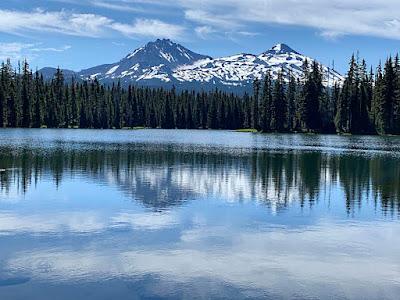
North Sister and Middle Sister, as seen from Scott Lake off Oregon Highway 242.
On July 13, we found the road to Scott Lake snow-free. Beargrass was blooming and so were mosquitoes. I zipped on my mosquito-net jacket before opening the car door and made a mental note to wait for a time with fewer bugs, maybe late August or even September, before camping there. Meanwhile, seeing Scott Lake reflect the snowy Sisters completed my scenic drive experience beyond expectations.
Was my many-months-long anticipation rewarded? Yes! At McKenzie Pass, the unobstructed panorama of the Cascade Range, world-class lava field to the horizon, and unusual tower made of lava blocks were well worth devoting a day to the drive. Postcard-perfect Proxy Falls, Scott Lake, and Sisters were great bonuses.
Even the slow miles of “same old” Oregon-scenic-road-winding-through-evergreen-forest delighted me with a fresh thought. Was this route any different from, say, portions of US Highway 101 along the Pacific Coast or of the Wallowa Mountain Loop in the northeast corner of the state? Could evergreen and deciduous species, roadside soil, and contours of the land be telltale clues? Surely there’s a children’s story in there…
All text and photos, copyright Caroline Arnold. www.theintrepidtourist.blogspot.com
